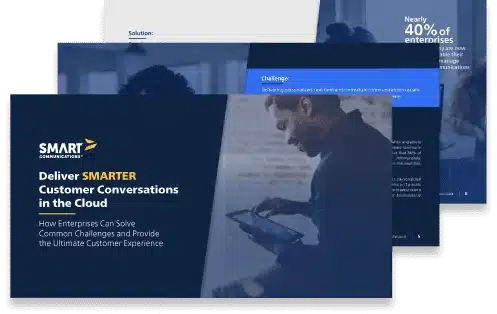3 Reasons to Rethink How You Collect Customer Information
By: Neal Keene, Field CTO at Smart Communications
According to a recent Forbes article , in 2021 we can expect the customer experience to become increasingly conversational. But what does this really mean for your business, and how can you ensure you’re set up to succeed?
From acquisition to onboarding and servicing, businesses must ensure the end-to-end customer experience is better than ever – and that begins with how information is collected. Customers need to provide information throughout their lifecycle with a business, which often means asking them to fill out a form. Unfortunately, this touchpoint is oftentimes neglected, creating impersonal, friction-filled and frustrating customer experiences.
Let’s discuss three ways enterprises can optimize their forms processes, ultimately reducing abandonment rates while simultaneously building brand loyalty and creating a more conversational experience.
1. Legacy tools like paper-based or PDF forms are off-putting.
All too often, businesses ask customers to either download, print and scan paperwork, or enter already known information into an online form. And if forms aren’t web or mobile friendly, customers may avoid engaging altogether – 50% of consumers prefer online forms versus a paper-based process and 35% want forms to be easy to access on mobile.
2. Nearly 60% of customers will abandon a form if the process is too difficult.
The majority of consumers – nearly 60% — recently indicated they would be likely to abandon an interaction if a company has an inefficient process for collecting information. However, in the same report, we uncovered that adaptive forms – where companies gradually collect data at strategically timed intervals – are the least common means of collecting customer information. Most organizations are still using a combination of paper (about 50%) or static, online forms (nearly 60%).
3. The future of customer conversations is digital-first.
Companies need to understand customers on an individual level to uncover new ways to meet their needs and provide additional value. If interactions are still paper-based and static, enterprises risk creating a significant gap between what customers expect and what is being delivered. Cloud-based solutions that provide intelligent, conversational user experiences allow businesses to gradually collect data at strategically timed intervals, and only ask customers relevant questions that consider previous answers with the ability to start and stop the form without losing information.
As businesses rethink customer engagement, it’s time to shift away from one-way, transactional communications to meaningful, two-way customer conversations. And, investing in forms transformation is a key step in optimizing the end-to-end customer experience.
Beyond collecting information and checking boxes, redefining how information is gathered means businesses can respond quickly and via preferred channels – a critical component of every stage within the customer lifecycle. Smart forms modernize the collection and use of customer information, empower customers to initiate conversations with businesses and remove friction from critical interactions.
Enterprises must engage their customers in dynamic, two-way conversations, which means they must more effectively collect customer information and then use that information to respond appropriately, quickly and via preferred channels – something that remains critical throughout every stage of the customer lifecycle.
To learn how Smart Communications can power your business’ forms transformation, check out SmartIQTM.



